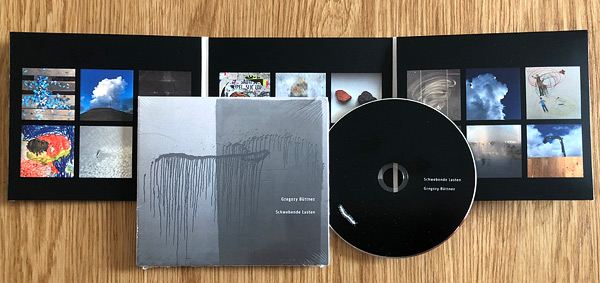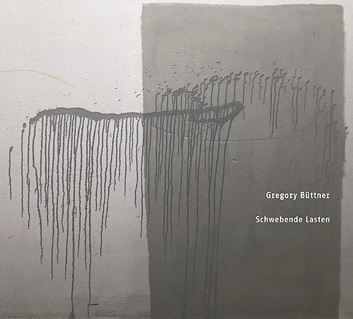CD, 150 copies, 6-panel digisleeve
released by 1000füssler, 2024
Listen and digital: bandcamp
Buy CD, include shipping to: Schwebende Lasten 1 (2’04’’)
Schwebende Lasten 2 (4’24’’)
Schwebende Lasten 3 (3’51’’)
Schwebende Lasten 4 (5’40’’)
Schwebende Lasten 5 (9’45’’)
Schwebende Lasten 6 (3’26’’)
Schwebende Lasten 7 (5’00’’)
Schwebende Lasten 8 (5’24’’)
Schwebende Lasten 9 (2’21’’)
Schwebende Lasten 10 (10’38’’)
The basic sounds of the pieces were all created with a Buchla and some with a Serge analog modular synthesizer during my residency at EMS Stockholm, 2013. After this part of the sound creation (and with some files further digital processing), I played the results through different external loudspeakers, which I prepared with resonant objects such as tin cans, tubes, paper, metal plates, wooden boxes or small objects. This mixture of acoustic and electro-acoustic sounds was then re-recorded and assembled into the final compositions.
Pictures by Gregory Büttner, first in the bottom row by Jim Büttner, last in the top row by Yella Büttner.
Music by Gregory Büttner, (GEMA)
Many thanks to EMS for my residency and to the Goethe Institute for giving me a grant to work there.

REVIEWS:
CHAIN D.L.K. (Italy, USA)
Gregory Büttner’s "Schwebende Lasten" (German for "Suspended Loads") is an album of fragile architectures - sonic structures suspended delicately in the air, each note and texture balanced as if on the edge of collapse. It’s a testament to the art of tension and resonance, a suite of electroacoustic compositions that transforms the mechanical into the poetic and the inert into the vividly alive.
The genesis of the album lies in the legendary halls of EMS Stockholm, where Büttner employed a Buchla and Serge modular synthesizer to create the initial palette of sounds. But it’s what happens next that defines the album’s unique identity. Those initial tones - crafted with the precision of a watchmaker - are projected through an array of resonant objects: tin cans, tubes, metal plates, wooden boxes. These materials, humble and quotidian, are animated by soundwaves, their natural vibrations becoming integral to the compositions. Büttner then re-recorded these interactions, creating a dialogue between the analog, the acoustic, and the digital.
The result? A series of pieces that are as tactile as they are abstract. The opening track, "Schwebende Lasten 1", is a fleeting overture, its two-minute duration akin to a thread being pulled taut. As the album progresses, longer pieces like "Schwebende Lasten 5" and "Schwebende Lasten 10" immerse the listener in soundscapes that seem both alien and eerily familiar - like listening to the echoes of a machine dreaming of its origins.
Büttner’s process is one of collaboration - not just with his synthesizers but with the objects themselves. The tin cans and wooden boxes act as co-conspirators, their vibrations adding layers of unpredictability and depth. It’s as though Büttner has tapped into the secret frequencies of the everyday, revealing the hidden music of mundane materials. The result feels strangely alive, like a modern-day alchemist coaxing gold from solder and scrap metal.
Ironically, despite the album’s title - "Schwebende Lasten" - these "loads" don’t feel burdensome at all. Instead, they float weightlessly, their tensions resolved not through release but through delicate equilibrium. Büttner’s compositions are finely tuned to the spaces between: between analog and digital, sound and silence, materiality and imagination.
The album’s limited edition CD release (a modest 150 copies) feels perfectly suited to the music’s intimate and ephemeral nature. There’s a sense of exclusivity here - not in a pretentious way, but in the way one might treasure a single, hand-folded origami crane. It’s an artifact as much as it is an album, an invitation to step into Büttner’s meticulously constructed world and to stay there, suspended, for as long as you can hold your breath.
Büttner, whose work often explores the intersection of sound and physicality, has crafted a record that not only engages the ears but also seems to vibrate against the very walls of the room. "Schwebende Lasten" is not just something you listen to; it’s something you inhabit. And like any well-built structure, it leaves you marveling at its balance, its ingenuity, and the quiet audacity of its maker.
Vito Camarretta, chaindlk.com
THE SOUNDPROJECTOR (UK)
Another fine set of experimental process-art from this Hamburg composer. If you heard this “blind”, you’d be sorely tested to identify anything or understand what’s happening; it’s still hard to believe that each of these ten pieces began life as analogue synth sounds, mostly made on the trusty Buchla though some were produced with a Serge.
Büttner made these original recordings when he had a residency at EMS Stockholm in 2013, a hub of creativity that has drawn many musical moths to its bright flame. What he did next was replay the recordings through a variety of loudspeakers, all of which have been “prepared” in old-school John Cage fashion – bits of metal, wood, ceramic and paper, and all manner of small objects are involved in the setup. All of this produces the fascinating percussive and rattle effects we hear on the finished record, which I have to assume are being created by familiar household objects being made to dance about on the platform by the vibrations caused by the electronic music. This is what I mean by “hard to believe” above. But more to the point, it shows Gregory Büttner’s allegiance to one of the precepts of electronic music composition, privileging the role of the loudspeaker.
When I spoke to Robert Worby in 2022, he said “We tend to overlook the fact that the loudspeaker turns electricity into sound, that’s what it does, and a microphone does the reverse of that. It turns sound into electricity, and once it’s electricity, there’s all kinds of things that can be done with the sound – it can be stored on tape, they can be processed using electronics and stuff, it can be filtered, all kinds of things can be done with it. And then the loudspeaker turns the electricity back into sound. We haven’t really moved on from that; there’s no other way.” This was his answer to me wondering out loud if there was any commonality between the numerous experimental music studios across the world; the simple answer is “loudspeakers”. The term “Schwebende Lasten” may have something to do with heavy loads suspended in space (for instance, a grand piano on the end of a derrick), which adds another layer of possibility to the work.
Ed Pinsent, August 18, 2024, thesoundprojector.com
VITAL WEEKLY (Dutch)
It’s interesting how often the EMS studios in Stockholm come up on these pages. Studios, as there are several: one for mixing in surround sound, one for regular mixing, and one housing the Serge and Buchla modular synths (among other facilities!). Very few people go in there to record and mix a piece in the traditionally finished way. Think of this as machines to generate a plethora of sounds and you record many of those and work on a composition at home. That’s what Gregory Büttner did in 2013. He also applied some digital processing. However, he does something else that not many do. He “played the results through different external loudspeakers, which I prepared with resonant objects such as tin cans, tubes, paper, metal plates, wooden boxes or small objects”. Thus, the strict electronic sounds mingle with acoustic sounds, and everything becomes vibrant. These electronic sounds set acoustic objects in motion, becoming highly unstable and irregular, adding a new texture to the music. The music has throughout a very percussive feeling, even with all the irregularities. Büttner works with many variations of the same approach, not only in the objects and electronic sounds he uses but also with the speed and intensity of the sounds. This means the music slows down at times or speeds up, takes an introverted turn, but also can be light and melodic. None of these pieces are straightforward one-of events, as within a piece, there are many changes, the whole slowing down/speeding up, creating different distinctive shifts. Perhaps that slight melodic touch is strange when much of the material is also very abstract. It’s music that defies easy categorisation. It’s not improvised music or electro-acoustic music on the ground of the mechanical process. Sound art or installation music covers it, and what’s essential: also without any visual stimulants, the music is still powerful.
Frans de Waard, vitalweekly.net/1435
BAD ALCHEMY (Germany)
GREGORY BÜTTNER Schwebende Lasten (1000füssler032): Sind damit Wolken gemeint, wie sie auf einigen Feldern von Bütterns Fotokunst markiert werden könnten, als 'Ich bin kein Roboter'-Test? Das akustische Ausgangsmaterial der 10 Tracks hat er bereits vor 10 Jahren mit Buchla und Serge-Synthis am EMS Stockholm generiert. Nach digital Processing als weiterer Formgebung wurden die auch so erst halbfertigen Stücke dann durch Lautsprecher geschickt, die der Hamburger präpariert hat mit Blechdosen, Röhren, Papier, Blech, Holzkistchen etc. Das hat er gemeinsam mit Birgit Ulher, seiner Partnerin zu zwei oder im Stark Bewölkt Quartett, die ähnlich ihren Trompetenklang modifiziert. So elektroakustifiziert erhielten die Stücke dann ihre nun zu hörende Gestalt. Als kleine Klopfer und Rubbler im Raum-Zeit-Kontinuum. Und als Zwitter, die man über weite Strecken ihrer Lebensdauer von mindestens 2'04” und maximal 10'38'' für rein perkussiv und händisch fabriziert halten könnte. Oder für Klänge wie von Russolos Intonarumori, insbesondere als kleine Schlagfolgen auf Metall, Holz etc., als Reiben, Surren, Knistern oder – bei 4 – als knatternde, tickende, klopfende Mechanik eines holzigen 'Uhrwerks'. Also deutlich abweichend von allem, was man mit Synthesizern verbindet. Und weiterhin näher an tinguelyesker Automatik und Motorik, als gedämpftes Tuckern, automatisch repetiertes Rappeln, klopfendes Tröpfeln wie auf ein Blechdach oder eine Tonne. Bei 7 tribbeln Tanzschühchen und tickern automatische Hämmerchen zu fragilen und zwitschrigen Lauten. Dann schwebt tatsächlich dongender Hall als dröhnende Welle im Raum, reißt aber ab für kurze eiserne Kratzer und ein sirrendes Prickeln. Bei dongenden Schlägen wie an eine Stahltrosse scheinen die Hand und das Rohr mit Händen zu greifen. Bis zuletzt bei der knarrenden, siedenden, tröpfelnden, wischelnden 10 Perkussion, Mechanik, Motorik und Tanz vexieren als überblendete Illusionen. Und Büttner hat ja tatsächlich die Musik für das tanz-akrobatische Duett “1004 Zentimeter Mut” gemacht.
Rigo Dittman, BA 124, www.badalchemy.de
Top
